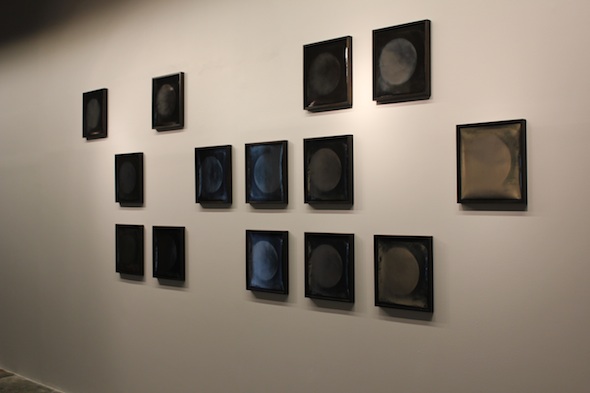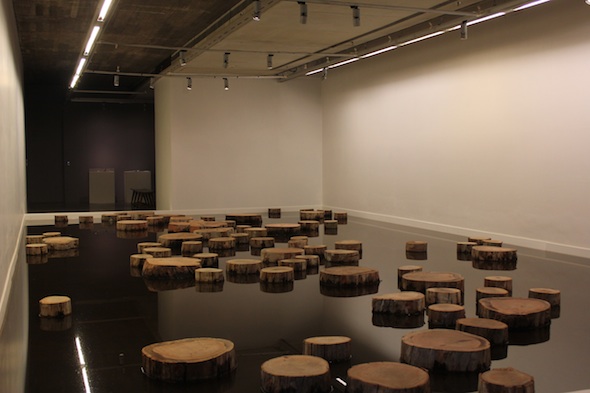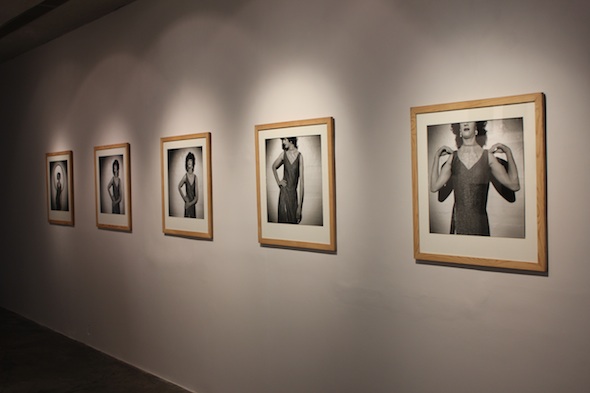The India Profiles series focusses on established and emerging art institutions, galleries, museums and artist residencies in India. Every month we will feature a different art space and discuss their upcoming and ongoing exhibitions and programs.
 Lisa Oppenheim – “Heliograms July 8th, 1976/ July 11th, 2013,” toned photographs, exposed with sunlight, framed with museum glass 12.2 x 12.9 inches; courtesy Devi Art Foundation
Lisa Oppenheim – “Heliograms July 8th, 1976/ July 11th, 2013,” toned photographs, exposed with sunlight, framed with museum glass 12.2 x 12.9 inches; courtesy Devi Art Foundation
For the first edition of our India Profiles series, we talked to New Delhi-based art institution Devi Art Foundation about their ongoing exhibition Black Sun: Alchemy, Diaspora, and Heterotopia curated by Shezad Dawood and Tom Trevor, as well as the role their foundation plays in the Indian art world and beyond.
BAL: Can you tell us a bit about your current show Black Sun?
Devi Art Foundation: The exhibition looks at a group of artists who use or encounter the iconography of the Black Sun, or engage with a spirit of alchemy and hermetic meaning that seems to parallel the inner journey, and its consequent relationship to the larger context of the 20th Century and on into the present. As there is no one path, and each artist presents their own universe, what we have is a series of interlinking and discursive possibilities, that point to what the French philosopher Michel Foucault termed ‘heterotopia,’ many possibilities co-existing and each presenting their own unique environment.
The artists on view are the following : Ayisha Abraham, Ashish Avikunthak, Matti Braun, James Lee Byars, Maya Deren, Desire Machine Collective, Zarina Hashmi, Runa Islam, Nasreen Mohamedi, Lisa Oppenheim, The Otolith Group, Tejal Shah and Alexandre Singh.
 Matti Braun – “R.T./S.R./V.S.” (2003), 12 wood, foil, water, dimensions variable; Courtesy BQ, Berlin and Esther Schipper, Berlin and Devi Art Foundation
Matti Braun – “R.T./S.R./V.S.” (2003), 12 wood, foil, water, dimensions variable; Courtesy BQ, Berlin and Esther Schipper, Berlin and Devi Art Foundation
BAL: What do you see as Devi’s role within the Indian subcontinent and the international art community more generally?
Devi Art Foundation: A number of factors contribute to the country and Delhi’s fast growing art scene, the galleries, the museums and the various non profit art spaces that have strongly made cultural and production hubs around the city. Delhi has over 200 commercial art establishments spread across the city.
We see our role firmly embedded in the cultural life of the city. We are a foundation which seeks to create a space for new thinking and creative ideas to take shape. It’s through the life of these ideas that we hope to make a mark nationally and internationally.
BAL: As a foundation, in what ways do you differ from a gallery? What kind of educational programmes do you offer?
Devi Art Foundation: It is a well known story that there is a lack of government support for contemporary art. The place of a not-for-profit art institution is very different from the objectives and aims of a commercial art gallery, which ultimately focus on selling art or that of the existing structure of government support for contemporary art. Our hope as a non-profit art space is to allow for ideas and works to grow, unbounded by commercial limitations. We are an art institution that encourages new ideas and works to be realized and shown, outside the scope of what the market dictates. Every vibrant art culture needs institutions and spaces that nurture this freedom. We do curated walks for children from different schools and have a larger outreach program of film screenings and workshops, which is not exclusively for children.
BAL: How are you able to avoid ‘commercial constraints’ for artists that you show?
Devi Art Foundation: We know that the boom and the bust of art prices can dictate terms in the art world. This is part of living in such tumultuous times. As a foundation we are driven by the need to create a space for expression. We encourage young artists and are constantly looking at new works that are made by younger artists. Our outreach programs are open to the public free of cost. The Devi Art Foundation attempts to be a space where people can come to discuss and share ideas. We feel the art scene is growing, despite little support from the government. It is not entirely dependent on what the market dictates. There are various individuals and groups doing exciting new things and exploring new possibilities of engaging with the public. This passion for making and exploring are the very cornerstones of an open art culture.
 Tejal Shah – “Unfurling I – V” (2000), black and white silver gelatin print on fiber based paper 20 x 20 inches each; courtesy Devi Art Foundation
Tejal Shah – “Unfurling I – V” (2000), black and white silver gelatin print on fiber based paper 20 x 20 inches each; courtesy Devi Art Foundation
___________________________________________________________________________________
Additional Information
DEVI ART FOUNDATION
“Black Sun: Alchemy, Diaspora, and Heterotopia” – GROUP SHOW
Exhibition: Nov. 9, 2013 – Apr. 27, 2014
Sirpur House, Plot no. 39 (click here for map)
________________________________________________________________
Blog entry by Alison Hugill in Berlin; Thursday, Apr. 17, 2014.


























